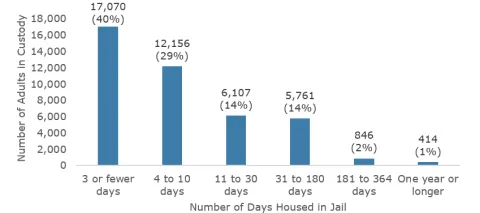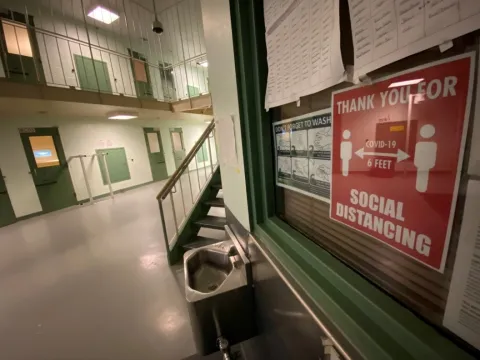Changes in the classification process could yield benefits for adults in custody and the Sheriff's Office
When jail managers decide where individuals will be housed and how much interaction they will be able to have with other people in the jails, they are using a process called classification. The National Institute of Corrections says a standardized, evidence-based classification process in jails is important to make sure people are safe, secure, and best able to reintegrate into the community. Some aspects of the Sheriff’s Office classification process were supported by research, but making changes could improve the consistency of the assessments and information gathered during the process.
The Sheriff's Office has a variety of classification levels
The focus of this audit was on describing conditions in the jails; we did not audit the classification survey instrument or its underlying rationale. This information on classification levels is provided to inform community knowledge about jail operations.
Corrections administrators and researchers design classification systems to identify people who are more likely to be dangerous to themselves and other people in the jail or are more likely to attempt to escape so they can be assigned to housing with more restrictions. Jail administrators place individuals who they believe are less likely to cause problems or who are not likely to be at risk from other adults in custody into housing that offers more freedom and access to programming, such as work within or even outside the jails. Sheriff’s Office policies and procedures specified that individuals will be housed in the least restrictive “custody conditions reasonable to ensure the safety and security of inmates, staff, and the facility.”
- Classification type: Lowest Risk
- Housing Type: Open dorm housing specifically for those with a job in the jail
- Jail: Inverness
- Classification type: Low to medium risk
- Housing Type: Mostly open dorm housing, but there is some single cell housing
- Jail: Inverness
- Classification type: Low to medium risk with mental health conditions
- Housing Type: Open dorm housing specifically for those with mental health conditions
- Jail: Inverness
- Classification type: High risk
- Housing Type: Single cell housing
- Jail: MCDC
- Classification type: High risk with mental health conditions
- Housing Type: Single cell housing specifically for those with mental health conditions
- Jail: MCDC
- Classification type: Discipline
- Housing Type: Single cell discipline areas where walk time and visitors may be greatly reduced
- Jail: MCDC or Inverness
Source: Information based on interviews with Multnomah County Sheriff’s Office staff. Table by the Multnomah County Auditor’s Office.
The Sheriff's Office makes initial housing assignments at booking
The Sheriff’s Office conducts classification interviews during the booking process. Individuals are generally brought into booking immediately after arrest. The interview model is a decision-tree type survey, where Sheriff’s Office classification staff ask people a series of standard questions that are answered yes or no and then follow-up questions are asked depending on their answers to the initial questions. The questions cover a variety of topics, including the individual’s physical and mental health, as well as individual needs while in custody, such as protection from other adults in custody. Some questions, such as whether the individual believes they may be susceptible to being the victim of sexual abuse while in custody, are required by law.
The classification staff also have access to data systems with information about the individuals. For example, the staff can see how many times the individual has been in custody, what they were being charged with, past history of violence or discipline within the jails, and past behavior alerts. This information, along with classification staff’s personal experiences with the individuals while they were in the jail previously, are all included in the assessment and housing decision.
After classification staff make their initial housing assignment, the staff periodically review the housing assignment – a process called reclassification – and may change an individual’s housing assignment accordingly. Unlike initial classification, reclassification criteria are principally based on the individual’s current behavior. The Sheriff’s Office reviews individual housing decisions every 14 to 30 days or after a significant event, such as when an individual is moved to disciplinary housing for violating rules.
Prior to the COVID-19 pandemic, the Sheriff’s Office housed individuals according to the classification decision as soon as the appropriate housing, as determined by classification staff, was available. When appropriate housing wasn’t yet available, adults in custody were temporarily housed in MCDC. With the pandemic, every individual coming into the jail was housed at MCDC for a quarantine period; they were then moved to their appropriate housing. About 40% of individuals who were booked and moved into jail housing were released within 72 hours of their arrival. This means that these people were released before they were moved into appropriate housing – making the classification interview and decision moot.
About 40% of adults in custody were housed in jail for 3 or fewer days

The Sheriff's Office classification procedures were generally consistent with national recommendations, but may be undercut
The National Institute of Corrections found that classification research suggests that properly applied classification systems improve safety and security by reducing rule breaking and violence. They also found research to show that the availability of and participation in programming for individuals housed in lower security units within the jail leads to improved community re-entry and transition, and less recidivism.
However, for a classification system to have these sorts of results, it must be consistently applied. Subjective models tend to rely on informal criteria that often lead to inconsistency and a tendency for classification staff to assign individuals to more restrictive housing than necessary. The National Institute of Corrections found that research shows that classification systems that place greater emphasis on fairness, consistency, and openness in the decision-making process use standard interviews and data to compute a score that translates into a classification decision.
The Sheriff’s Office said they worked with the National Institute of Corrections and designed the classification survey to be standardized, data driven, and to assign people to housing based on their current circumstances. But the classification procedures allow for staff to override the survey-based scores based on their previous experience with individuals. Information from previous experience and the ability to override the classification interview can be useful, but it can also have the effect of turning the instrument into a subjective one – potentially defeating the purpose of the instrument in the first place.
Research evaluated for the National Institute of Corrections suggests that staff face incentives to over-classify individuals – putting individuals into higher levels of security than necessary – because staff perceived there were fewer risks in over-classifying. The Sheriff’s Office management agreed that this incentive to over-classify exists.
Having classification decisions reviewed by a supervisor would be one way to monitor for over-classification. The classification manager told us that currently the only classification decisions subject to supervisory review were those that involve the highest level of security and protective custody. He said that the volume of classification work precludes additional supervisory review.
Delaying the in-depth classification interview could yield a more appropriate housing decision as well as other benefits
Provided it can be done while meeting safety concerns and legal requirements, delaying the in-depth classification interview until at least 72 hours after booking would provide a number of benefits. Conducting an initial classification assessment at booking and delaying an in-depth interview would have resulted in more than 17,000 fewer in-depth classification interviews between July 1 of 2018 and June 30 of 2021, a reflection of the number of people who were released within 72 hours. Such a reduction would allow for expanding the jail’s use of supervisory review of housing decisions. This would add an important layer to monitor for inappropriate over-classification of adults in custody.
Delaying the in-depth classification interview could potentially improve other aspects of the booking and classification process.
- Removing an in-depth classification interview will speed up the booking process.
- The Sheriff’s Office can conduct the interviews with more privacy for the individual, increasing the likelihood that they will share important information about any vulnerabilities they have.
- Waiting for 2-3 days post booking allows for individuals that come into booking under the influence of substances to be better able to answer the classification survey questions.
The ability to make improvements in the classification process, such as delaying the classification interview, may depend on the Sheriff’s Office having flexibility in making housing decisions. There is less flexibility when the jails are at or near capacity, something that is out of the Sheriff’s Office control.

